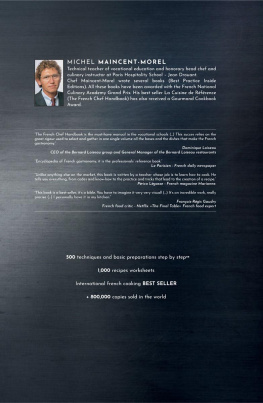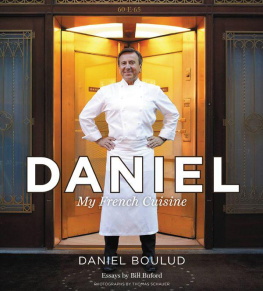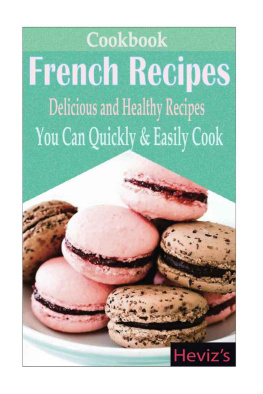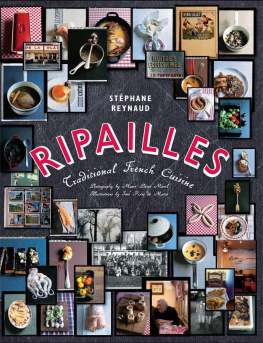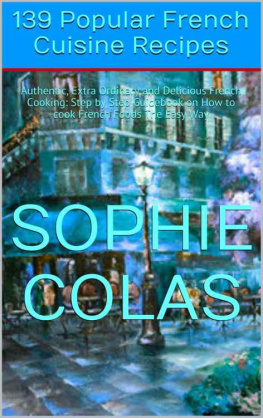Contents
Guide
Page List
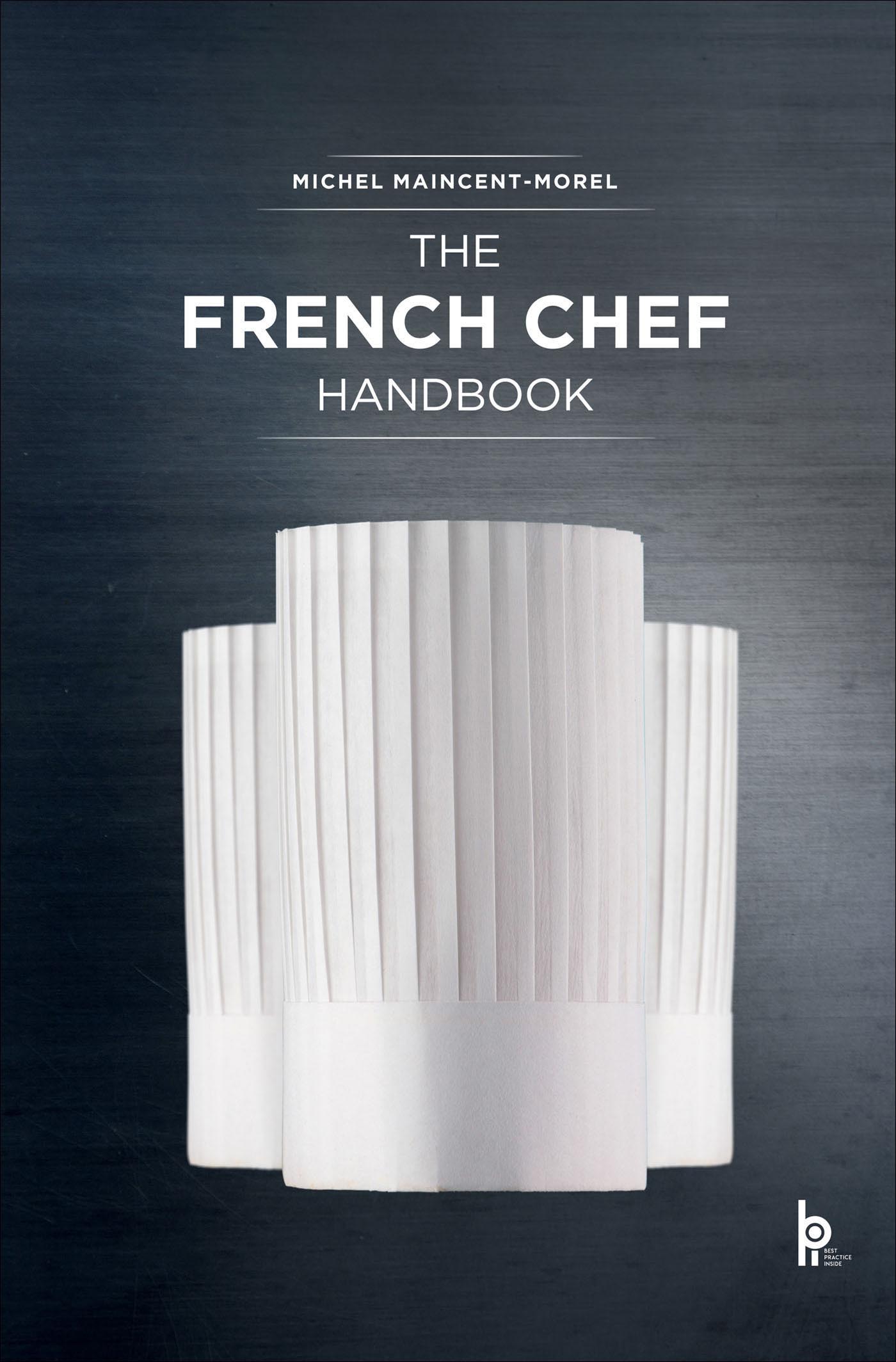

Author
Michel Maincent-Morel
Photographs
Y. Poccard-Chapuis - Michel Maincent-Morel
Graphic design
Sandra Cantaloube
Adrien Midzic
ISBN 978-2-85708-695-6
eISBN: 979-8-88707-081-0
Our Education Partners wish to offer their expertise, their educational content and their financial contribution to the creation, updating, digitization and distribution of Editions BPI content. In this way, they help all professionals to upskill. We would like to thank them for this.

Limit of liability / Disclaimer of warranty:
While the publisher and author have used their best efforts in preparing this book, they make no representations or warranties with respect to the accuracy or completeness of the contents of this book and specifically disclaim any implied warranties of merchantability or fitness for a particular purpose. No warranty may be created or extended by sales representatives or written sales materials.
This book is the translation of the original edition La Cuisine de Rfrence published in France. The original content of this book has been written according to France and European Unions rules and regulations, especially regarding food hygiene, food handling and safety at work.
You should always check rules and regulations in force in the area where they work or live, and always consult the local health department for information and guidance. The advice and strategies contained in this book may not be suitable for your situation. You should always consult with a professional where appropriate. Neither the publisher nor author shall be liable for any loss of profit or any other commercial damages, including but not limited to special, incidental, consequential, or other damages.
ditions BPI 2019
Rights to all translation, adaptation and reproduction by any means reserved for all countries.
Any representation or reproduction, in full or in part, of the texts and illustrations made without the consent of the author or their beneficiaries or concessionaires is illicit (French Law No. 57-298 of 11 March 1957, Article 40 paragraph 1).
A representation or reproduction by any means whatsoever (photocopies, photos, films) shall constitute a punishable infringement under Article 425 et seq. of the French Penal Code. Under paragraphs 2 and 3 of Article 41 of the French Law No. 57-298 of 11 March 1957, only copies or reproductions strictly for personal use and not for any collective use, and analyses and short citations used solely for examples and illustrations are permitted.
AUTHORS NOTE:
Working with food, and more specifically working in catering, requires special attention to many hygiene rules. The aim of these rules is to provide customers and clientele with healthy, honest food that is both delicious and nutritious.
These rules may seem somewhat discouraging, even tiresome, but they are not at all restrictive and quickly become instinctive, allowing you to progress more quickly.
Do not forget that the customer can see you and will judge the establishment you work in and represent based on your appearance, uniform, behaviour, attitude as well as your politeness and courtesy.
This book was written according to French regulations and hygiene standards. You must always respect rules and regulations in force in the country and area you work or live.
Acknowledgements:
Photos
Y. Poccard-Chapuis - Michel Maincent-Morel
Videos
All videos included on this book are available on the platform bpi campus
www.bpi-campus.com
Premises
Management of Jean-Drouant Hospitality and Catering School
20, rue Mdric - 75017 Paris
Equipment
E. Dehillerin
18/20, rue Coquillire - 75001 Paris
Mauviel
47, route de Caen - 50800 Villedieu-Les-Poles Welbilt - Mr. Rmi Le Naour
Nestl Food-Service France
Various suppliers
Pcherie des Lilas - Paris, Boucheries Roger - Paris
With the participation of
Victor Bride - Head chef, Thierry Lenormand - Professor of ptisserie, Vincent Sitz, Karil Lopez and the final-year students at the Jean-Drouant Hospitality and Catering School.
The author is extremely grateful to the heads of the establishments willing to lend their equipment and use of their premises.
He would also like to offer his profound thanks to all of the colleagues and experts who provided their invaluable help.

ditions BPI
1 Boulevard des Bouvets
92 000 Nanterre
www.editions-bpi.fr
bpi@editions-bpi.fr
PREFACE

THE FRENCH CHEF HANDBOOK is the key textbook for professional vocational schools in preparation for professional exams.
The success of this book is due to the great precision with which all the bases and dishes that make up French gastronomy have been selected and compiled in one single volume. It is a comprehensive book that is easy to adapt to everyday life.
THE FRENCH CHEF HANDBOOK includes all the recipes that have formed the foundation of French cuisine for centuries. A range of dishes derived from these timeless recipes, from which French cuisine has evolved, has also become established throughout the decades.
In the first part, basic techniques and preparations as well as professional skills are illustrated with an impressive number of more than 2000 photos. The recipe sheets in the second part are illustrated with 1300 photos (base recipes, essential recipes and derived recipes).
The QR codes also allow you to watch videos of certain techniques.
It is the knowledge and mastery of the basics of French cuisine its roots that allows every chef to create their own menu, using their imagination, senses and originality, without limits, according to the type of catering they wish to do. What is more, it gives the customer the most enjoyment!
We sometimes come across forms of experimentation which mainly attempt at such things as creating new consistencies, destructuring/restructuring, looking for substitutes and creating different textures (emulsion, flocculation, gelification, spherification, smoking, nitrogen freezing). As these have not been subject to regulation, hygiene or safety, they have not been covered in this edition. Their nutritional value also needs to be approved. Only time will tell which of these experiments will last.
Gastronomy, as shown in this book, is one of the most important parts of the French way of life. The inclusion of the Repas gastronomique la franaise (gastronomic meal of the French) as part of Unescos Intangible Cultural Heritage means that the characteristics of this way of life are forever preserved: the specificities of the cultural roots, the huge variety of food products, the many culinary techniques. But, more than that, it also recognises the entire culture of the French restaurant: its rituals, the time devoted to each meal, the importance of three daily meals, the sequence of dishes that make up a menu, social rites (togetherness, sharing, exchange, meetings, conversation), as well as all the other culinary arts (tableware, silverware, glassware, linen, decoration).

